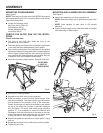
3
RULES FOR SAFE OPERATION
Safe operation of this accessory requires that you read and
understand this operator's manual, the operator’s manual
for the miter saw and all labels affixed to the tool.
READ ALL INSTRUCTIONS
n KNOW YOUR ACCESSORY. Read the operator's manual
carefully. Learn the product's applications and limitations
as well as the specific potential hazards related to this
product.
n KEEP THE WORK AREA CLEAN. Cluttered work areas
and work benches invite accidents. DO NOT leave tools
or pieces of wood on the saw while operating.
n ALWAYS WEAR SAFETY GLASSES WITH SIDE
SHIELDS. Everyday eyeglasses have only impact-
resistant lenses; they are NOT safety glasses.
n DO NOT USE THIS PRODUCT WITH OTHER EQUIP-
MENT or for other purposes.
n ALWAYS DISCONNECT THE SAW FROM THE POWER
SUPPLY BEFORE ASSEMBLING THIS KIT. Make sure
the switch is off when reconnecting the saw to a power
supply.
n BEFORE MAKING A CUT, BE SURE ALL ADJUSTMENTS
ARE SECURE.
n Always get help if you need to lift the workstand. When
lifting, hold the workstand close to your body. Bend your
knees so you can lift with your legs, not your back.
n When hauling the workstand in a vehicle, securely tie it
down to prevent movement and possible damage.
n NEVER put the workstand where operator's or bystander
are forced to stand with any part of their body inline with
the path of the saw blade.
n NEVER STAND ON WORKSTAND. Serious injury could
occur if the stand tips or you accidentally hit the cutting
tool. Do not store any items above or near the stand
where anyone might climb on the stand to reach them.
n Maximum weight of power tool must not exceed 100
pounds.
n Maximum weight of saw and workpiece must not
exceed 200 pounds.
n Always mount miter saw so the workpiece is positioned
in-line with the roller assemblies.
n Check to make sure workstand does not rock, slide or
move prior to use.
n Put the workstand on a firm level surface where there
is plenty of room to handle and properly support the
workpiece.
n SAVE THESE INSTRUCTIONS. Refer to them frequently
and use them to instruct other users. If you loan someone
this product, also loan these instructions.
WARNING:
Some dust created by power sanding, sawing,
grinding, drilling, and other construction activities
contains chemicals known to cause cancer, birth
defects or other reproductive harm. Some examples
of these chemicals are:
• lead from lead-based paints,
• crystalline silica from bricks and cement and
other masonry products, and
• arsenic and chromium from chemically-treated
lumber.
Your risk from these exposures varies, depending
on how often you do this type of work. To reduce
your exposure to these chemicals: work in a well
ventilated area, and work with approved safety
equipment, such as those dust masks that are
specially designed to filter out microscopic
particles.


















